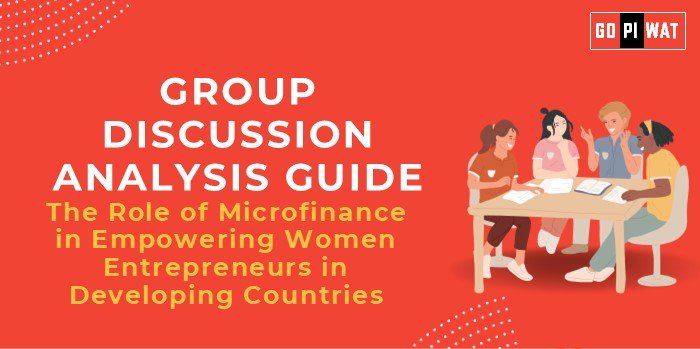📋 Group Discussion Analysis Guide
Topic: The Role of Microfinance in Empowering Women Entrepreneurs in Developing Countries
🌐 Introduction to Microfinance and Women Entrepreneurship
Context: Microfinance has become a cornerstone for socio-economic development, particularly in addressing gender disparity in developing countries. With women constituting over 70% of microfinance borrowers globally, its role in entrepreneurship cannot be overstated.
Background: Initiated as a tool to alleviate poverty, microfinance emerged from the success of Grameen Bank in the 1970s. It has evolved to become a key driver of financial inclusion and gender empowerment.
Relevance: B-school aspirants must understand microfinance’s impact on women entrepreneurs as it integrates key aspects of finance, sustainability, and socio-economic development.
📊 Quick Facts and Key Statistics
- 🌍 Global Borrowers: 70% of microfinance borrowers are women, showcasing its gender-focused impact.
- 👩💼 Employment: Women entrepreneurs account for 37% of small and medium enterprises (SMEs) in developing nations, many supported by microfinance.
- 📈 Economic Growth: Microfinance contributes to 3%-5% of GDP in countries like Bangladesh and Nepal.
- 💳 Loan Repayment Rates: Women borrowers exhibit a 98% repayment rate globally, highlighting their reliability and creditworthiness.
🤝 Stakeholders and Their Roles
- Microfinance Institutions (MFIs): Provide loans, training, and support (e.g., Grameen Bank, BRAC).
- Governments: Facilitate policy frameworks to promote microfinance and women’s entrepreneurship.
- International Organizations: Offer funding and advisory, e.g., World Bank and UN Women.
- Community Networks: Support women entrepreneurs through mentorship and peer collaboration.
📈 Achievements and Challenges
✨ Achievements
- Financial Inclusion: Over 200 million women globally gained financial access through microfinance.
- Entrepreneurship Growth: Increased the number of women-led SMEs in South Asia and Sub-Saharan Africa by 15% in a decade.
- Poverty Reduction: Helped lift 32 million women out of poverty (World Bank, 2022).
⚠️ Challenges
- High Interest Rates: Many MFIs charge up to 24%, limiting scalability.
- Limited Reach: Rural areas often lack access to MFIs due to infrastructural gaps.
- Cultural Barriers: Socio-cultural norms restrict women’s participation in economic activities in some regions.
🌍 Global Comparisons and Case Studies
Bangladesh: Grameen Bank empowers millions of women with affordable loans.
Kenya: Mobile-based microfinance platforms like M-Pesa have significantly impacted women-led businesses.
India: SEWA (Self Employed Women’s Association) supports over 1.5 million women through microfinance and capacity-building programs.
📌 Structured Arguments for Discussion
- Supporting Stance: “Microfinance has proven transformative by enabling financial independence and entrepreneurship among women in rural areas.”
- Opposing Stance: “High-interest rates and limited reach make microfinance inaccessible to the poorest women entrepreneurs.”
- Balanced Perspective: “While microfinance empowers women economically, addressing structural and operational inefficiencies is critical for scalability.”
💡 Effective Discussion Approaches
- Data-Driven Start: “With women constituting 70% of microfinance borrowers, its role in entrepreneurship is undeniable.”
- Case-Based Start: “The Grameen Bank model illustrates how microfinance transforms women’s lives in rural Bangladesh.”
Counter-Argument Handling: “High interest rates are a challenge, but MFIs like BRAC have introduced tiered interest models to ensure affordability.”
📋 Strategic Analysis of Strengths and Weaknesses
- Strengths: Enhances financial access, high repayment rates, fosters community growth.
- Weaknesses: High costs, low digital adoption in rural areas.
- Opportunities: Digital microfinance, gender-focused policies, cross-sector partnerships.
- Threats: Political instability, cultural resistance.
🏫 Connecting with B-School Applications
- Real-World Applications: Case studies on financial inclusion or sustainable business models.
- Sample Interview Questions:
- “How can microfinance accelerate gender equality in developing economies?”
- “Discuss the role of technology in transforming microfinance for women entrepreneurs.”
- Insights for Students: Explore microfinance as a theme in business strategies or community-driven CSR initiatives.


